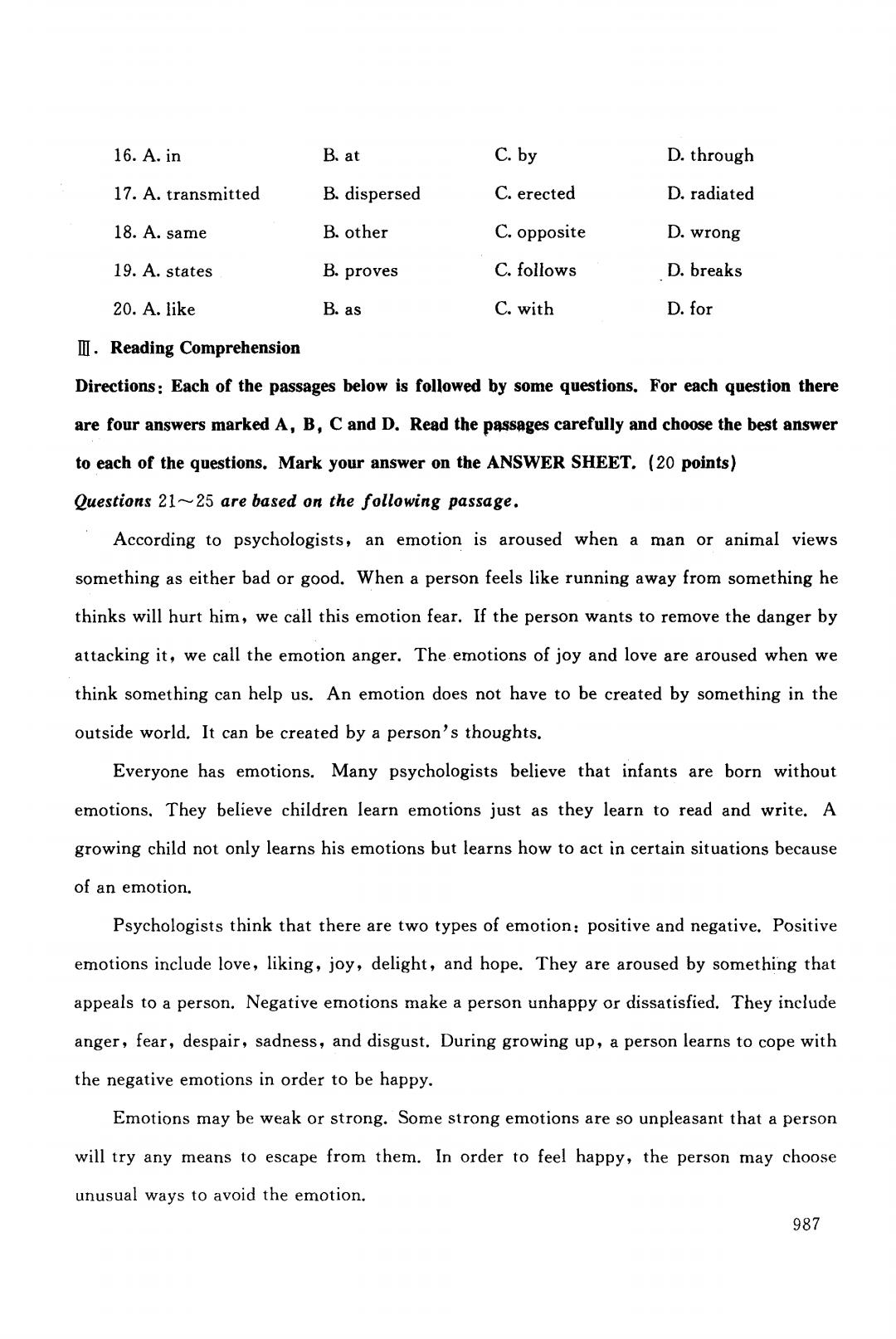正在加载图片...

16.A.in B.at C.by D.through 17.A.transmitted B.dispersed C.erected D.radiated 18.A.same B.other C.opposite D.wrong 19.A.states B.proves C.follows D.breaks 20.A.like B.as C.with D.for I.Reading Comprehension Directions:Each of the passages below is followed by some questions.For each question there are four answers marked A,B,C and D.Read the passages carefully and choose the best answer to each of the questions.Mark your answer on the ANSWER SHEET.(20 points) Questions 21~25 are based on the following passage. According to psychologists,an emotion is aroused when a man or animal views something as either bad or good.When a person feels like running away from something he thinks will hurt him,we call this emotion fear.If the person wants to remove the danger by attacking it,we call the emotion anger.The emotions of joy and love are aroused when we think something can help us.An emotion does not have to be created by something in the outside world.It can be created by a person's thoughts. Everyone has emotions.Many psychologists believe that infants are born without emotions.They believe children learn emotions just as they learn to read and write.A growing child not only learns his emotions but learns how to act in certain situations because of an emotion. Psychologists think that there are two types of emotion:positive and negative.Positive emotions include love,liking,joy,delight,and hope.They are aroused by something that appeals to a person.Negative emotions make a person unhappy or dissatisfied.They include anger,fear,despair,sadness,and disgust.During growing up,a person learns to cope with the negative emotions in order to be happy. Emotions may be weak or strong.Some strong emotions are so unpleasant that a person will try any means to escape from them.In order to feel happy,the person may choose unusual ways to avoid the emotion. 98716. A.in 17. A. transmitted 18. A. same 19. A. states 20. A. like B. at B. dispersed B. other B. proves B. as C. by c. erected C. opposite C. follows C. with D. through D. radiated D. wrong D. breaks D. for 田. Reading Comprehension Directions: Each of the passages below is followed by some qu臼tions. For each qu臼tion there are four answers marked A , B, C and D. Read the Qli ag ll and choωe the 回t answer to each of the questions. Mark your answer on the ANSWER SHEET. (20 points) Questions 21~25 are based on the following passage. According to psychologists, an emotion is aroused when a man or animal views something as either bad or good. When a person feels like running away from something he thinks will hurt him , we call this emotion fear. If the person wants to remove the danger by attacking it , we call the emotion anger. Theemotions of joy and love are aroused when we think something can help us. An emotion does not have to be created by something in the outside world. It can be created by a person's thoughts. Everyone has emotions. Many psychologists believe that infants are born without emotions. They believe children learn emotions just as they learn to read and write. A growing child not only learns his emotions but learns how to act in certain situations because of an emotion. Psychologists think that there are two types of emotion: positive and negative. Positive emotions include love , liking , joy , delight , and hope. They are aroused by something that appeals to a person. Negative emotions make a person unhappy or dissatisfied. They include anger, fear , despair , sadness, and disgust. During growing up , a person learns to cope with the negative emotions in order to be happy. Emotions may be weak or strong. Some strong emotions are so unpleasant that a person will try any means to escape from them. In order to feel happy , the person may choose unusual ways to avoid the emotion. 987